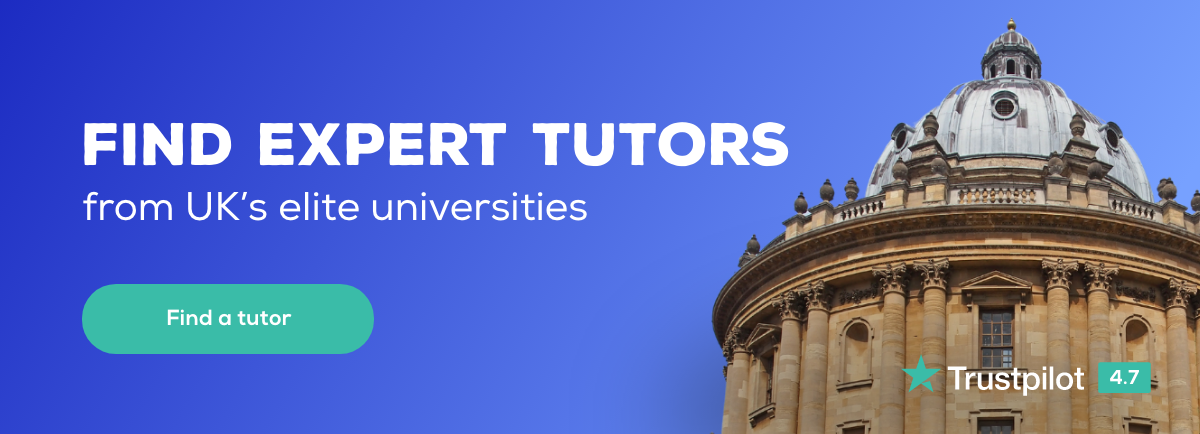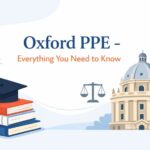Geometry is a vital part of the GCSE Maths curriculum, and mastering it is crucial for students aiming to achieve high grades. This guide will provide an in-depth look at each topic covered in GCSE Geometry, offering clear explanations and practical tips to enhance understanding and performance. Whether you’re revising for exams or seeking to strengthen your understanding, this guide is designed to help you grasp essential principles and solve geometric problems with confidence. Equip yourself with the tools you need to excel in your GCSE Geometry studies.
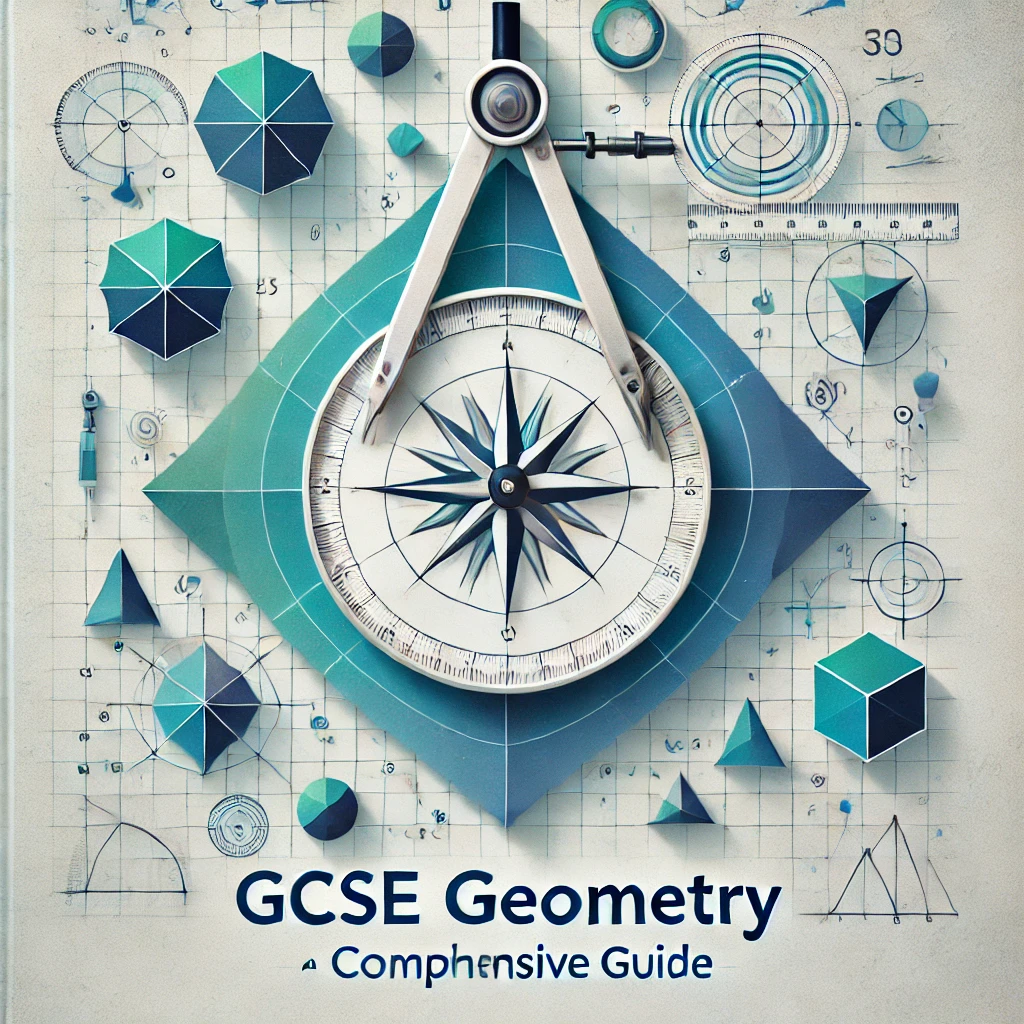
Understanding Basic Geometric Shapes and Properties
Geometry begins with understanding various shapes and their properties. At the core are 2D shapes like triangles, quadrilaterals, and circles. Each of these shapes has unique properties, such as area and perimeter:
Triangles: With three sides and three angles, triangles can be classified into types like equilateral, isosceles, and scalene, each with specific properties. The sum of angles in any triangle is always 180 degrees.
Quadrilaterals: These include squares, rectangles, parallelograms, and trapeziums. Each has four sides and distinct angle properties. For instance, squares and rectangles have four right angles, while the opposite angles of a parallelogram are equal.
Circles: Defined by their centre and radius, circles have properties such as diameter, circumference, and area. Understanding these helps in solving problems related to arcs and sectors.
In contrast, 3D shapes like cubes, spheres, and pyramids introduce concepts of volume and surface area:
Cubes and Cuboids: These shapes have six faces, and their volume is calculated by multiplying length, width, and height. Surface area involves summing the area of all faces.
Spheres: These perfectly round shapes have formulas for volume
and surface area
where r is the radius
Pyramids and Cones: These shapes taper to a point, with pyramids having a polygonal base and cones having a circular base.
Understanding these shapes’ properties helps students build a strong foundation in geometry, crucial for tackling more complex problems and applications.
Exploring Angles and Their Relationships

Angles are a fundamental part of geometry, providing the foundation for understanding more complex geometric concepts. In GCSE Maths, students explore various types of angles and their relationships within different shapes.
Types of Angles
- Acute, Right, and Obtuse Angles:
- Acute angles are less than 90 degrees, found in many geometric figures.
- Right angles are exactly 90 degrees, commonly seen in squares and rectangles.
- Obtuse angles are greater than 90 degrees but less than 180 degrees
- Complementary and Supplementary Angles:
- Complementary angles add up to 90 degrees, often seen in right triangles.
- Supplementary angles add up to 180 degrees, forming a straight line when placed together.
- Angles Around a Point and on a Straight Line:
- The angles around a point sum to 360 degrees, a crucial concept for solving circle-related problems.
- Angles on a straight line add up to 180 degrees, forming the basis for understanding linear pair relationships (Go Teach Maths).
Angle Relationships in Polygons
Understanding angles within polygons is vital for solving various geometric problems:
- Triangles:
- The sum of the interior angles of a triangle is always 180 degrees. This rule is used to find unknown angles in triangles.
- Quadrilaterals:
- The sum of the interior angles of a quadrilateral is 360 degrees. Knowing this helps in calculating angles in squares, rectangles, and other four-sided figures
Mastering Transformations

Transformations in geometry involve changing a shape’s position, size, or orientation while preserving its essential properties. Understanding transformations is crucial for solving various geometric problems and has practical applications in fields like computer graphics and design.
Types of Transformations
- Translation:
- Definition: Translation involves moving a shape from one position to another without changing its size, shape, or orientation.
- Properties: All points of the shape move the same distance in the same direction. The shape remains congruent to its original form.
- Application: Translation can be described using a vector, indicating the direction and distance of the movement.
- Reflection:
- Definition: Reflection is a transformation that flips a shape over a line, creating a mirror image.
- Properties: The line of reflection is the perpendicular bisector of the line segment joining each point and its image. The original shape and its reflection are congruent.
- Application: Reflections are used in symmetry analysis and are fundamental in creating symmetrical designs.
- Rotation:
- Definition: Rotation involves turning a shape around a fixed point, known as the centre of rotation.
- Properties: A shape can be rotated by a specific angle in a clockwise or counterclockwise direction. The shape remains congruent to its original form.
- Application: Rotation is used in various fields, including art and engineering, to create patterns and analyse mechanical movements.
- Enlargement (Dilation):
- Definition: Enlargement involves resizing a shape by a scale factor relative to a fixed point, known as the centre of enlargement.
- Properties: The shape maintains its proportionality, but the size changes. If the scale factor is greater than 1, the shape enlarges; if it’s between 0 and 1, the shape reduces.
- Application: Enlargement is used in real-world scenarios, such as resizing images and scaling models in architecture and engineering.
Exploring Transformations with Coordinates
In GCSE geometry, transformations are often explored using coordinates on a grid:
Translation: Each point (x, y)of a shape moves to a new position (x + a ,y + b), where (a,b) is the translation vector.
Reflection: Shapes can be reflected across axes or other lines. For example, reflecting a point (x,y) across the y-axis results in (−x,y).
Rotation: A point (x,y) can be rotated about the origin by 90 degrees, 180 degrees, etc. For instance, a 90-degree counterclockwise rotation transforms (x,y) to (−y,x).
Enlargement: Coordinates (x,y) are multiplied by the scale factor, resulting in (kx, ky), where k is the scale factor.
By mastering transformations, students develop the ability to visualise and manipulate shapes, a skill that is valuable in both academic settings and practical applications.
Similarity and Congruence in Shapes
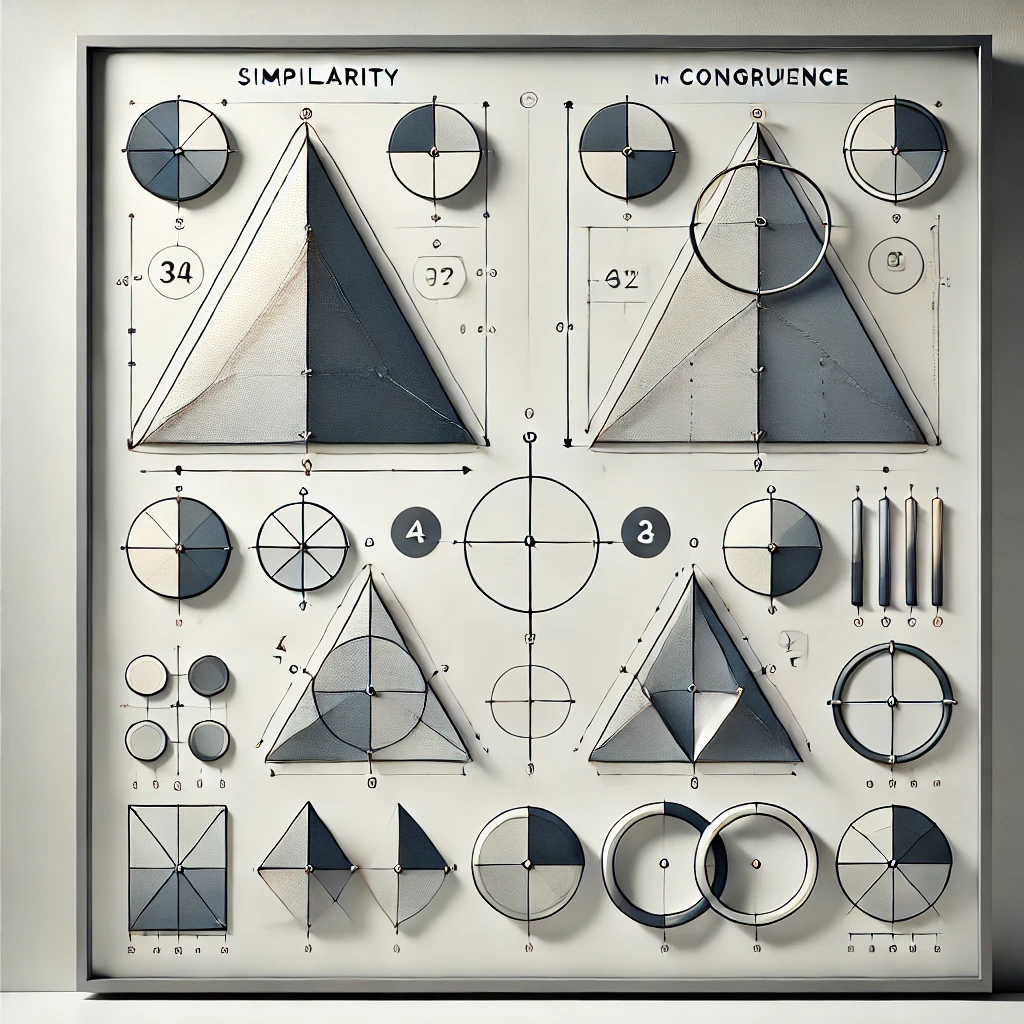
Understanding similarity and congruence is crucial in geometry, as these concepts help determine when two shapes have the same form or size. They are fundamental in solving various geometric problems and have practical applications in fields like architecture, engineering, and art.
Congruence in Shapes
Congruent shapes are identical in form and size. This means that if one shape can be transformed into another using a series of rigid transformations (translations, rotations, or reflections), then the shapes are congruent.
Properties of Congruent Shapes:
- Corresponding sides are equal in length.
- Corresponding angles are equal.
- The shapes can be superimposed onto each other perfectly.
Congruency Tests for Triangles: There are specific criteria to determine the congruence of triangles, including:
- SSS (Side-Side-Side): All three sides in one triangle are equal to all three sides in another triangle.
- SAS (Side-Angle-Side): Two sides and the angle between them in one triangle are equal to two sides and the angle between them in another triangle.
- ASA (Angle-Side-Angle): Two angles and the side between them in one triangle are equal to two angles and the side between them in another triangle.
- AAS (Angle-Angle-Side): Two angles and a non-included side in one triangle are equal to two angles and a corresponding non-included side in another triangle.
- RHS (Right Angle-Hypotenuse-Side): For right-angled triangles, the hypotenuse and one other side in one triangle are equal to the hypotenuse and one other side in another triangle.
Similarity in Shapes
Similar shapes have the same shape but not necessarily the same size. They can be obtained from each other by scaling (enlarging or reducing) along with translations, rotations, or reflections.
Properties of Similar Shapes:
- Corresponding angles are equal.
- Corresponding sides are in proportion.
Similarity Tests for Triangles: The similarity of triangles can be established using these criteria:
- AAA (Angle-Angle-Angle): If two angles of one triangle are equal to two angles of another triangle, then the triangles are similar.
- SAS (Side-Angle-Side) Similarity: If two sides of one triangle are in proportion to two sides of another triangle, and the included angles are equal, then the triangles are similar.
- SSS (Side-Side-Side) Similarity: If all three sides of one triangle are in proportion to all three sides of another triangle, then the triangles are similar.
Practical Applications
Understanding similarity and congruence is essential for solving problems involving geometric figures, including:
- Scale Models: Creating accurate scale models of structures and objects in architecture and engineering.
- Map Reading: Using similarity to interpret scales on maps.
- Design and Art: Ensuring symmetry and proportion in artistic and design work.
By mastering the concepts of similarity and congruence, students develop the ability to analyse and compare geometric shapes, enhancing their problem-solving skills and mathematical understanding.
Applying Pythagoras’ Theorem
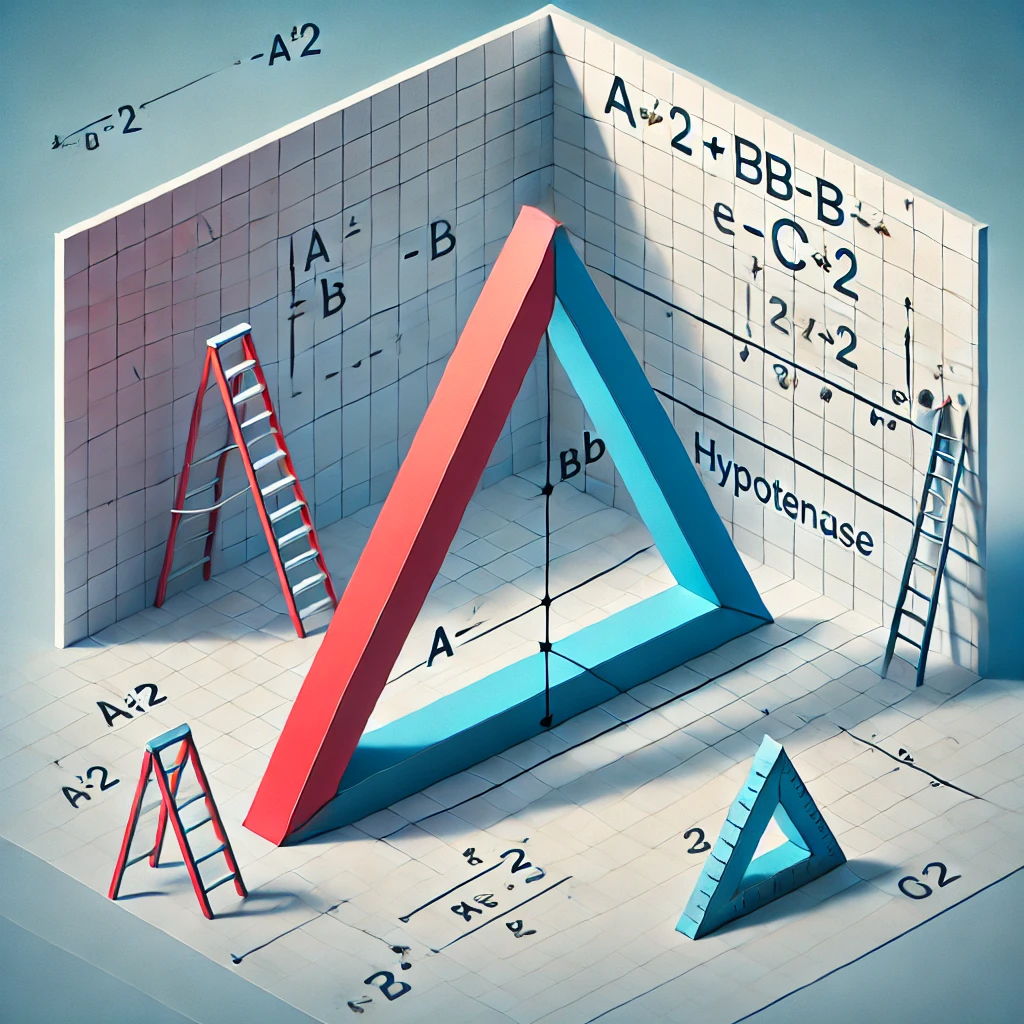
Pythagoras’ Theorem is one of the most well-known and widely used theorems in mathematics. It provides a relationship between the sides of a right-angled triangle, making it an essential tool for solving various geometric and real-world problems.
Understanding Pythagoras’ Theorem
Theorem Statement: In a right-angled triangle, the square of the hypotenuse (the side opposite the right angle) is equal to the sum of the squares of the other two sides. Mathematically, it is expressed as:
where ccc is the length of the hypotenuse, and a and b are the lengths of the other two sides.
Applications of Pythagoras’ Theorem
Finding Side Lengths:
Hypotenuse: If the lengths of the two shorter sides (a and b) are known, the hypotenuse (c) can be found using the formula
Legs of the Triangle: If the hypotenuse and one side length are known, the other side can be found using the rearranged formula
Real-World Applications
- Construction and Engineering: Pythagoras’ Theorem is used to calculate distances and ensure structures are level and square.
- Navigation and Mapping: The theorem helps calculate the shortest distance between two points, essential in navigation and GPS technology.
- Art and Design: It aids in creating right angles and proportional designs in various creative fields.
Problem Solving
- Diagonal of a Rectangle or Square: The theorem can find the diagonal length when the side lengths are known.
- Distance Between Two Points: In coordinate geometry, Pythagoras’ Theorem helps find the distance between two points on a grid by treating the difference in x-coordinates and y-coordinates as the two legs of a right triangle.
Example Problems
Finding the Hypotenuse:
Problem: A right-angled triangle has sides of length 3 cm and 4 cm. Find the hypotenuse.
Solution: Using
Finding a Missing Side:
Problem: A right-angled triangle has a hypotenuse of 10 cm and one side of 6 cm. Find the other side.
Solution: Using
By understanding and applying Pythagoras’ Theorem, students can solve a wide range of mathematical and practical problems, enhancing their analytical and problem-solving skills.
Trigonometry

Trigonometry is a branch of mathematics that explores the relationships between the angles and sides of triangles. This field is essential in GCSE mathematics, offering powerful tools for solving problems related to angles and distances in various geometric contexts.
The Basics of Trigonometry
Trigonometry primarily deals with right-angled triangles and introduces three fundamental ratios: sine, cosine, and tangent. These ratios are crucial for calculating unknown sides or angles in right-angled triangles and have applications in numerous real-world scenarios.
Fundamental Trigonometric Ratios
Sine (sin):
In a right-angled triangle, the sine of an angle is the ratio of the length of the opposite side to the length of the hypotenuse.
Cosine (cos):
The cosine of an angle is the ratio of the length of the adjacent side to the hypotenuse.
Tangent (tan):
The tangent of an angle is the ratio of the length of the opposite side to the adjacent side.
Using Trigonometry to Solve Problems
Trigonometry is used to find unknown angles and sides in right-angled triangles:
Finding an Unknown Side: If one side length and one angle are known, the trigonometric ratios can be used to find the other side lengths. For example, to find the opposite side, use sin\sinsin, or to find the adjacent side, use cos.
Finding an Unknown Angle: If two sides are known, inverse trigonometric functions e.g.,
can be used to find the angle
Real-World Applications of Trigonometry
Trigonometry is not limited to academic exercises, it has practical applications in various fields:
- Architecture and Engineering: Trigonometry is used to calculate heights, distances, and angles in the design and construction of structures.
- Astronomy: It helps calculate distances between celestial bodies and angles of inclination.
- Navigation and Surveying: Trigonometry is used to determine positions, plot courses, and measure land.
Example
Problem: A ladder is leaning against a wall, forming a 60-degree angle with the ground. If the ladder is 10 metres long, how high up the wall does it reach?
Solution: Use the sine ratio to find the height (h)
The ladder reaches approximately 8.66 metres up the wall.
By understanding and applying trigonometry, students gain valuable skills for solving a wide range of mathematical and practical problems, enhancing their analytical and problem-solving abilities.
Circle Theorems and Their Applications
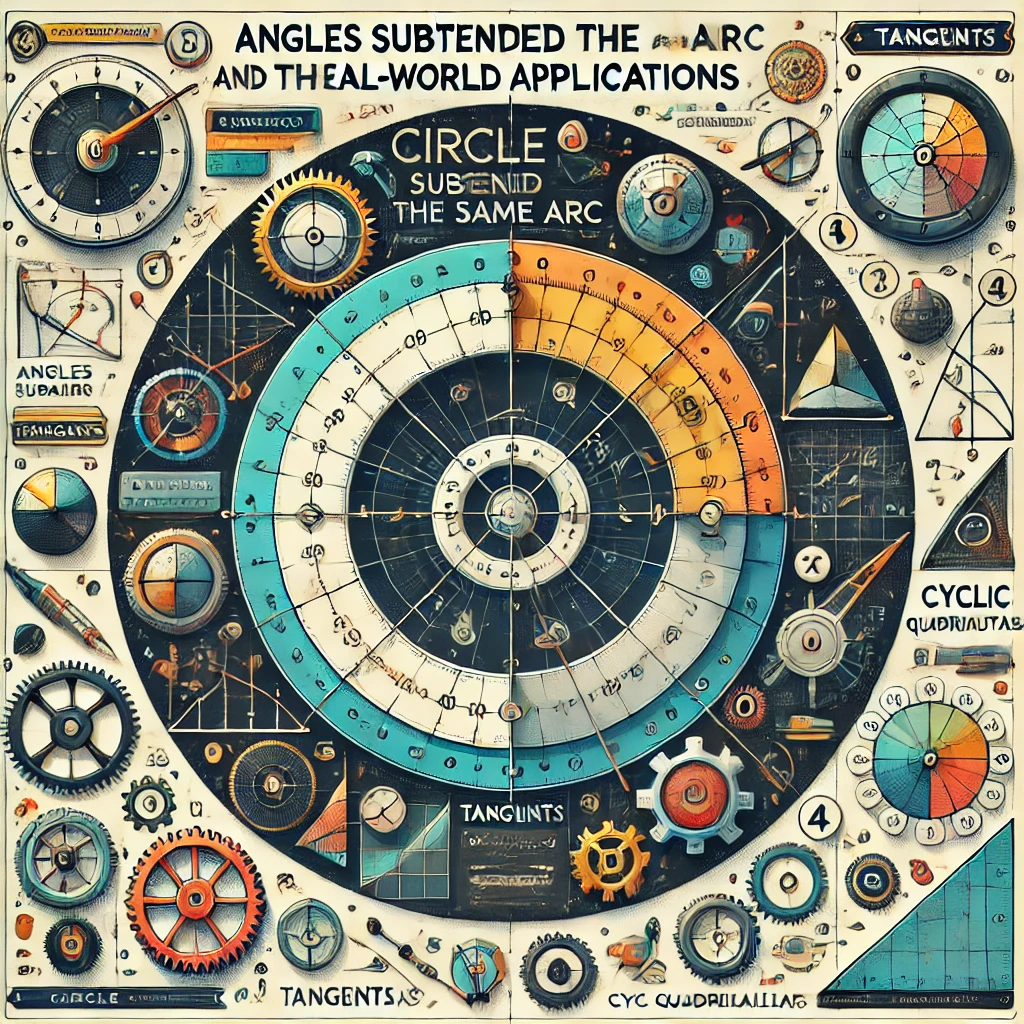
Circle theorems are a set of rules that describe the relationships between angles, radii, and lines in and around a circle. Understanding these theorems is essential for solving complex geometric problems involving circles and is a key component of the GCSE Maths curriculum.
Key Circle Theorems
- Angle at the Centre Theorem:
- Statement: The angle subtended at the centre of a circle by an arc is twice the angle subtended at any point on the circumference by the same arc.
- Application: This theorem helps in solving problems involving angles and arcs, such as finding missing angles in circle diagrams.
- Angles in the Same Segment Theorem:
- Statement: Angles subtended by the same arc in the same segment of a circle are equal.
- Application: This theorem is used to identify equal angles in circle-based problems, useful for solving questions related to cyclic quadrilaterals.
- Cyclic Quadrilateral Theorem:
- Statement: The opposite angles of a cyclic quadrilateral (a quadrilateral inscribed in a circle) sum to 180 degrees.
- Application: This theorem is used to find unknown angles in cyclic quadrilaterals, which often appear in GCSE exam questions.
- Tangent-Secant Theorem:
- Statement: The angle between a tangent and a chord through the point of contact is equal to the angle in the alternate segment.
- Application: This theorem is useful for solving problems involving tangents and chords, such as finding angles in complex diagrams.
- Perpendicular from the Centre Theorem:
- Statement: The perpendicular from the centre of a circle to a chord bisects the chord.
- Application: This theorem is used to find the midpoint of a chord or to solve problems involving the radius and chords.
Real-World Applications of Circle Theorems
Circle theorems are not just theoretical concepts; they have practical applications in various fields:
- Engineering and Design: Circle theorems help in designing mechanical components like gears and wheels, where precise angles and arcs are crucial.
- Architecture: Understanding circle properties aids in the design of structures with arches and circular elements.
- Astronomy: Circle theorems assist in calculating angles and distances between celestial bodies.
Example
Problem: A cyclic quadrilateral is inscribed in a circle. If one of its angles measures 70 degrees, find the measure of the opposite angle.
Solution: According to the cyclic quadrilateral theorem, the opposite angles of a cyclic quadrilateral sum to 180 degrees. Therefore, the opposite angle is:
This problem demonstrates the practical use of circle theorems in solving geometric problems.
By mastering circle theorems, students develop a deeper understanding of geometric relationships, enhancing their ability to solve complex problems and apply these concepts in real-world situations.
How should I study geometry?
Conclusion
Mastering GCSE Geometry requires a strong understanding of shapes, angles, and mathematical principles. By exploring each topic in detail and practising regularly, students can develop the skills needed to excel in their exams and apply geometry in real-world situations.
This guide has covered the key topics and concepts you need to understand, but if you find yourself struggling with any aspect of geometry, don’t hesitate to seek additional support. Hiring a private GCSE Maths tutor can provide personalised guidance, helping you overcome challenges and build the confidence needed to excel. With the right resources and support, you can achieve your full potential in GCSE Maths.
FAQ
What is GCSE Geometry?
GCSE Geometry is a branch of maths in the GCSE curriculum that deals with shapes, sizes, angles, and properties of space. It includes topics like triangles, circles, polygons, and coordinate geometry.
What is the hardest part of GCSE maths?
The hardest part of GCSE Maths is often problem-solving, especially in topics like algebra, geometry, and trigonometry, where applying concepts to complex questions can be challenging.
Is Geometry easier than Algebra?
It depends on individual strengths: some find geometry easier, while others find algebra simpler.


